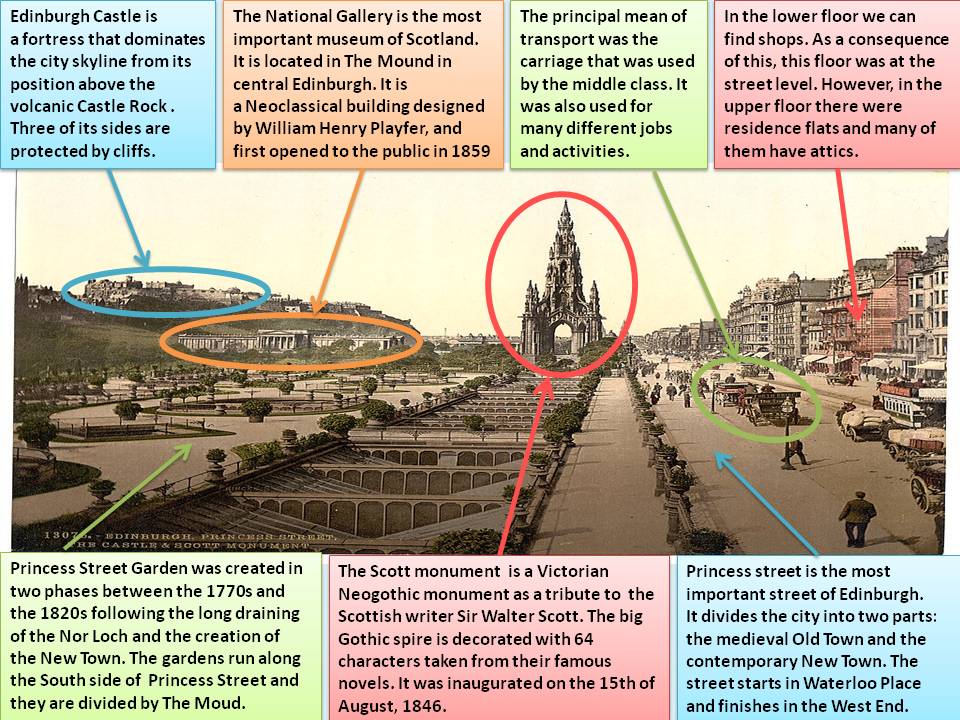The city represented in this picture is Edinburgh in the 19th century; we can observe the principal street of the city, Princess Street. It is hand water colored print of the city engraved by Dosso. The picture is offered to the public in La Galerie Napoleon, a Parisian antique dealer specialized in antique prints.
The first knowledge about the settlements in Edinburgh is in the roman era (there are metallic objects and ceramic of the late first century). Edinburgh was not the capital of Scotland until the end of the middle Ages; before that, the capital was in the place where the King and his court were. In the Middle Age, Edinburgh began as a small fort but in the 18th century, the Englishmen arrested it and called Einden´s burgh (burgh is a word that formerly meaning strong). Finally in the 10th century the Scottish recover this part of Scotland. At the end of the 11th century, Malcolm III built the castle in Castle Rock and built a small village around it. In that century there is knowledge about Edinburgh being a true hamlet, which its main activity was trade. In this era, friars also appeared. They could go out of the monastery for working or other tasks, always entrusted it by their supervisor. In Edinburgh there were two orders, the Dominicans (with black clothes) and the Augustinians (with grey clothes). Both lived in the South part of Edinburgh.
In the 15th century Edinburgh was declared capital of Scotland and the King built the first Palace of Holy rood. In the 16th century the Flooden Wall began to be built, this was the wall that surrounded the city with the intention of protecting it from the English. There was a problem, the city had a big wall but also a big population, so the only way to build the city was using height. In 1767 the planning of the New Town began, in this epoch monuments were erected like Calton Hill, The National Gallery, and the Walter Scott monument.
The picture represents the main street, Princess Street; it starts in Waterloo Place and finishes in the West End. This street was built in the 18th century, during the reign of George III, and divides the city in two parts, the Old town and the New town. We can observe in the left of the picture some beautiful gardens, but before this, that area was the most important loch in Edinburgh, the Nor Loch.
This loch, at the beginning was a marsh, and it was used like a natural defense for the city and the castle. Edinburgh had the North and the West part protected, and only walls were required at the South and the East part. Then the North Loch started to get dry and in 1820 the Princess Street Gardens were inaugurated. Nowadays the gardens are the most important park in Edinburgh. These gardens also divide the Old Town and the New Town. In this part we can also observe the castle; it was the first fortress for protecting the city. Under the castle we see the National Gallery; in this moment it was in construction. In the middle of the picture we can observe the Scott monument (it was inaugurated in 1846). It is a Gothic building in honor of the Scottish writer Sir Walter Scott. The builder was George Meikle Kemp, he was joiner and draftsman and self-taught architect. The monument has a black color with a sinister aspect. The big Gothic spire is decorated with 64 characters of their novels. Finally at the right side of the picture we can observe different people walking through Princess Street, the principal street that divides the Old and the New Town. We can also see transports like carriage; it was the principal way of transport of the middle class.
In the 14th century trade began to increase. Edinburgh began to be famous for its clothes of wool. The export of skin besides started in the Leith port, the cattle was sold in Cowgate and the cereals and wheat were exchanged in Grassmarket. With the New town, the population of Edinburgh grew because Scotland began to have a political and religious activity, and a big economic development. The entire city was built around the Castle. Nowadays with the big population the Castle is not in the middle, but it still is the main structure. In the old part the streets do not have a regular structure, but in the new part everything is built in an orthogonal way. That is why we find a regular and lineal structure in all the streets.
Esther Rodríguez-Rabadán Mateos-Aparicio

